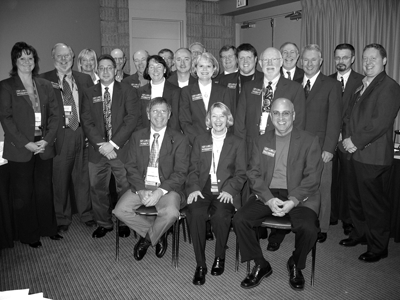Approximately 7,600 optometric professionals attended this years Southern Council of Optometrists (SECO) meeting in Februarya 9.5% increase over last years meeting and the highest total attendance since the 2001 event, according to a SECO spokesperson.
Indeed, Georgias World Congress Center, in Atlanta, was packed with optometrists, certified ophthalmic technicians, opticians and paraoptometric professionals. And they all shared one goal: to obtain great optometric education in order to better serve their patients.
 |
| The CE Committee volunteers were a primary part in making SECO 2006 a success and educationally enriching. |
Dr. Laskerr and his fellow O.D. colleagues were able to accomplish their goals, as this years meeting offered 83 courses for optometrists, including nine new educational tracks and nine new special sessions. A sampling of these tracks: Retina Revisited, which covered the latest in retinal diagnosis and management, 21st Century Glaucoma Care and Infant/Binocular Vision, among others. The Binocular vision track drew over 100 doctors! says optometrist Paul C. Ajamian, chair of SECOs Continuing Education.
Examples of the special sessions: You Be The Judge, which gave attendees the chance to watch a mock malpractice trial, Cultural Diversity (Part 1 & 2), which provided insights to how optometrists can be culturally sensitive to the backgrounds of their patients, and the SECO Scholar Program: Ocular Disease Tune-up, which is a two-year program in which attendees must complete a one-hour online course in 2006 and 2007 and five hours live each year. An online exam is offered at the end of 2006 and 2007. Those attendees who successfully complete all the hours and pass both online exams graduate and receive an engraved SECO plaque to be presented at SECO 2008. The Cultural Diversity Workshop attracted more than 300 attendees, and more than 200 O.D.s signed up for the SECO Scholar Program, Dr. Ajamian says.
The increase in attendance at the event and at some of the education programs is due in part to feedback from the surveys that SECO sends out to attendees each year, says past SECO president Lowell Gilbert, O.D. We use feedback surveys as a method for improving education, exhibits and events, he says. We thrive on surveys. We constantly evaluate and assess them.
Dr. Gilbert formed a presidential task force to keep SECO on the cutting edge of educational programs. The task force assesses what the organization is doing correctly and what it could improve. The task force consists of one optometrist from academia, one from a subspecialty practice, one from industry and one from clinical practice. In addition to ensuring even better educational opportunities for attendees next year, the task force also examines ways to expand SECOs presence.
We want to spread the message that SECO International is not just a once-a-year meeting, says current president Sidney Stern, O.D. SECO is an organization that provides value, benefits and educational programs to its members all year long.
One of the ways SECO will expand its presence is by joining forces with Review of Optometry to host Bermuda 2006: A Meeting of Clinical Excellence, which will be held between July 13 and 16, in Hamilton, Bermuda. This meeting will include courses on refractive surgery, ocular surface disease, contact lenses, anterior segment, posterior segment, glaucoma and new technology.
SECO International 2007 will revisit Atlanta from February 21 to 25. More details will be forthcoming on www.secointernational.com.

